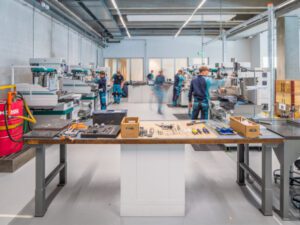Madame Djaffo, President of the Global Shea Alliance, outlines for International Confectionery Editor Hannah Larvin how her lifelong dedication to the shea industry shapes the future of this essential sector.
The Global Shea Alliance, which Madame Djaffo leads with voracious spirit, represents decades of experience and commitment to the shea industry. As Madame Djaffo shared, her journey in the industry began from a young age, learning from her mother. This deep-rooted connection to shea has not led to complacency but rather a determined focus on preserving the industry, advocating for economic empowerment of producers and maintaining high standards.
This commitment runs parallel with a strong emphasis on sustainability. The GSA has spearheaded initiatives to restore shea parks and promote sustainable practices that protect the environment while supporting the livelihoods of women in the sector. As highlighted by Madame Djaffo: “Sustainable practices are not just a modern trend but have been integral to our approach for many years. We are committed to ensuring that future generations can continue to benefit from the shea industry.” This sense of responsibility for both the environment and the well-being of producers exemplifies how the Global Shea Alliance is focused on the future, ensuring the industry’s growth and sustainability.
Summarised well by Madame Djaffo, “The voices of women in the shea industry must be heard, and their contributions must be recognised.”
Please introduce yourself and your role within the organisation.
I’m Madame Djaffo and I’m the President of the Global Shea Alliance. The GSA is a collective effort aimed at improving the shea industry, especially in West Africa, where shea is a critical resource for many communities. We focus on everything from production and processing to sustainability and market access.
How did being involved in the shea industry from a young age shape your values and approach?
Growing up, I watched my mother engage in the shea trade, from collecting the nuts to producing shea butter. This early exposure instilled in me a deep respect for the work and the women who perform it. It’s not just about the product; it’s about the people. This background has driven my commitment to improving the lives of women producers and ensuring that they receive fair treatment and compensation for their hard work. Over more than forty years, I’ve held various strategic positions within the sector, both nationally and internationally, always with a focus on development and quality.
What significant changes have you observed in the shea industry over the decades?
Over the decades, the shea industry has undergone substantial modernisation. We’ve seen the introduction of advanced machinery to improve the efficiency and quality of nut collection, kernel production and butter processing. There has also been a significant effort in organising and structuring the sector, with the formation of cooperatives, unions and associations, like the FNPK (Fédération Nationale des Productrices de Karité) in Benin, to strengthen the bargaining power of producers. Training and capacity building for members have been crucial in improving negotiation skills and ensuring higher incomes for women. Access to international markets has expanded, driven by organic certification and fair trade and we’ve also seen a greater focus on promoting sustainability through practices that protect shea parks and support reforestation.
Read the full feature in our magazine.
Never miss a story… Follow us on:
![]() International Confectionery
International Confectionery
![]() @InConfectionery
@InConfectionery
![]() @InConfectionery
@InConfectionery
Media contact
Hannah Larvin
Editor, International Confectionery
Tel: +44 (0) 1622 823 920
Email: editor@in-confectionery.com









